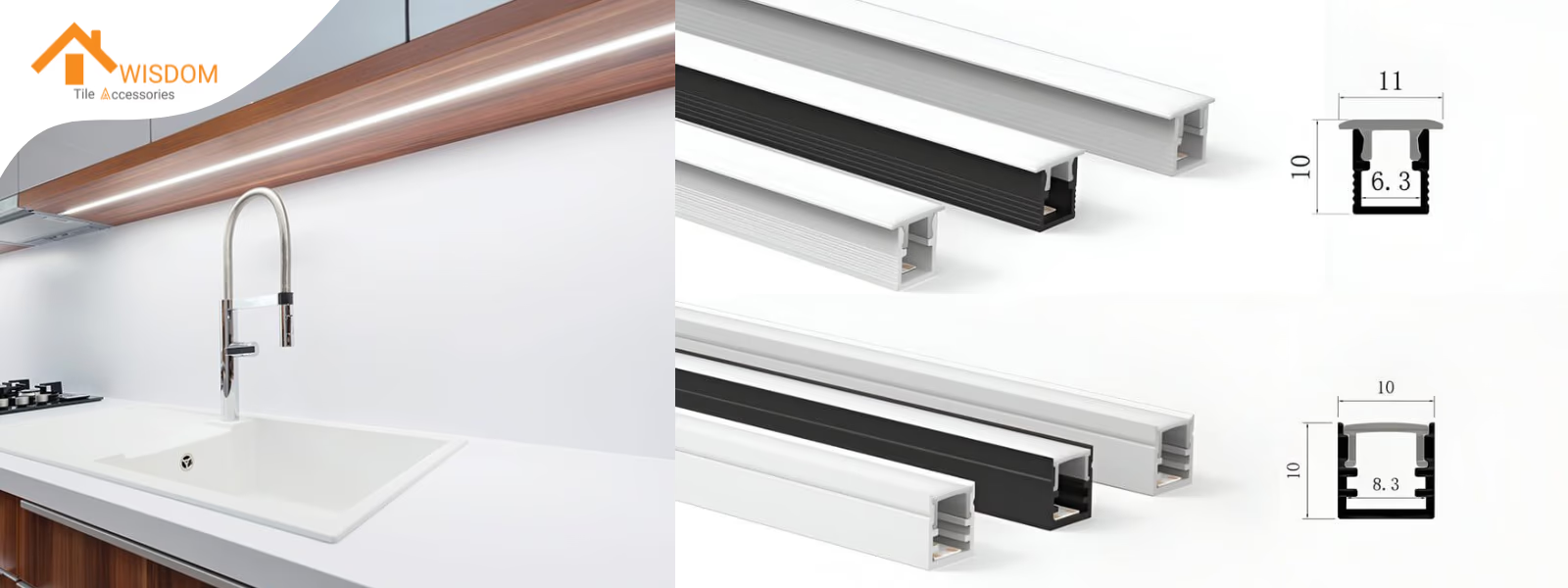Are you thinking about which kitchen under cabinet lighting to choose? Welcome to read this article, my friend, you will learn about the mainstream types of under cabinet lighting and their impact on your cooking. Please take some time to read, you will gain something.
What Is Under Cabinet Lighting
Under cabinet lighting consists of fixtures installed beneath your kitchen cabinets to illuminate your countertop workspace. These lights eliminate shadows from overhead lighting and create a more functional cooking environment while adding a beautiful ambiance to your kitchen.
Types of Kitchen Under Cabinet Lighting
LED Strip/Tape Lights
LED strip lighting represents the most versatile and contemporary solution for under-cabinet illumination. These flexible strips can be cut to precise lengths and offer seamless integration with most cabinet designs. Modern LED strips feature either COB (Chip on Board) or SMD (Surface Mount Device) technology, with COB providing a more uniform light without visible dots.

Highlights
Puck Lights
Puck lights offer a traditional approach to under-cabinet lighting, providing focused pools of light at regular intervals. These discrete circular units work particularly well in kitchens with irregular cabinet layouts or where specific task lighting is needed.

Highlights
Light Bars
Light bars combine the benefits of strip lights and puck lights into a pre-manufactured fixture. These rigid units offer a professional appearance and typically include all necessary components in one package.

Highlights
Things to Consider When Buying Under Cabinet Lights
Light Output
Color Rendering Index (CRI) measures a light source's ability to reveal colors faithfully compared to natural sunlight, rated on a scale of 0-100. Higher CRI means better color accuracy, which becomes crucial in kitchen environments where color perception affects both safety and quality of food preparation.
CRI levels in kitchen applications
Color Temperature, measured in Kelvin (K), indicates the warmth or coolness of light. This technical specification directly impacts both visual acuity and environmental comfort in kitchen spaces.
Temperature ranges and applications
Luminous Flux, measured in lumens per foot, determines the actual light output needed for various kitchen tasks. This specification ensures adequate illumination for safety and functionality.
Task-specific requirements
Power Systems
Voltage selection affects performance, installation requirements, and long-term reliability. Understanding voltage characteristics helps prevent common issues like brightness inconsistency and premature system failure.
System specifications
Power Supply (Driver) requirements determine system stability and dimming performance. Professional installations calculate exact power needs based on LED strip specifications and total run length.
Critical calculations
Installation parameters establish physical and electrical limitations that ensure optimal performance.
Technical constraints
Installation Methods
Hardwired integration
Hardwired integration connects your LED system directly to your kitchen's electrical system. The method requires an electrician but eliminates exposed power supplies and ensures precise dimming control. Most kitchen remodels now specify hardwired systems for their clean look and reliability.
Core components
Example: A 20-foot kitchen counter typically needs two LED drivers, mounted at opposite ends to minimize voltage drop. The system draws 4.8 watts per foot, requiring proper load balancing across drivers.
Plug-in systems
Plug-in systems use standard outlets but can still deliver professional results. The key lies in proper power supply placement and wire management. Many modern kitchens successfully use plug-in systems, especially in retrofits.
Key elements
Mounting Solutions
Surface-Mounted
Surface mounting works best with rigid LED fixtures and professional housings. The method requires proper support spacing and heat management. Most installers prefer this approach for its simplicity and reliability.
Hardware specs
Aluminum Channel Systems
Channel systems protect LEDs while shaping their light output. Aluminum channels with diffusers have become standard in professional installations. They solve multiple problems: heat, light quality, and protection.
Channel specs
Self-Adhesive
Adhesive mounting needs proper technique despite its apparent simplicity. Surface preparation and pressure application determine long-term success. Many installations combine adhesive with mechanical fasteners.
Mounting requirements
- Degreased surface
- High-bond tape
- Uniform pressure
- Operating temperature range
FAQs about Kitchen Under Cabinet Lighting
What is the best type of lighting for kitchen under cabinets?
LED lighting systems are the superior choice for under-cabinet installation. They provide maximum brightness while using 75% less energy than traditional options and last up to 50,000 hours. Modern LED strips offer built-in dimming and color adjustment features, making them versatile for both task and ambient lighting needs.
Should kitchen under cabinet lights be warm or cool?
For optimal kitchen lighting, use cool lights (4000K) under cabinets and warm lights (3000K) for overhead fixtures. Cool lighting enhances visibility for food preparation and detailed tasks, while warm lighting creates ambiance. This combination provides the perfect balance for both functionality and atmosphere.
How to hide lighting under kitchen cabinets?
Install under-cabinet lighting wiring through the cabinet backing and use a mounting channel along the front edge. This method conceals all wiring behind the cabinets while the channel hides the LED strips from direct view. Most modern cabinets have sufficient space behind them for clean wire routing.
Should under cabinet lighting be 3000K or 4000K?
Choose 4000K lighting for under-cabinet installation in kitchens. This color temperature provides optimal visibility for food preparation while maintaining natural color rendering. For kitchens with warm-toned cabinets or those seeking a cozier feel, 3500K offers an excellent middle ground.
What is the best position for under cabinet lights?
Mount under-cabinet lights 2.5 inches from the front edge of the cabinet. This placement provides maximum countertop illumination while preventing glare and hot spots. For wider countertops, consider installing a second row near the back edge for complete coverage.


